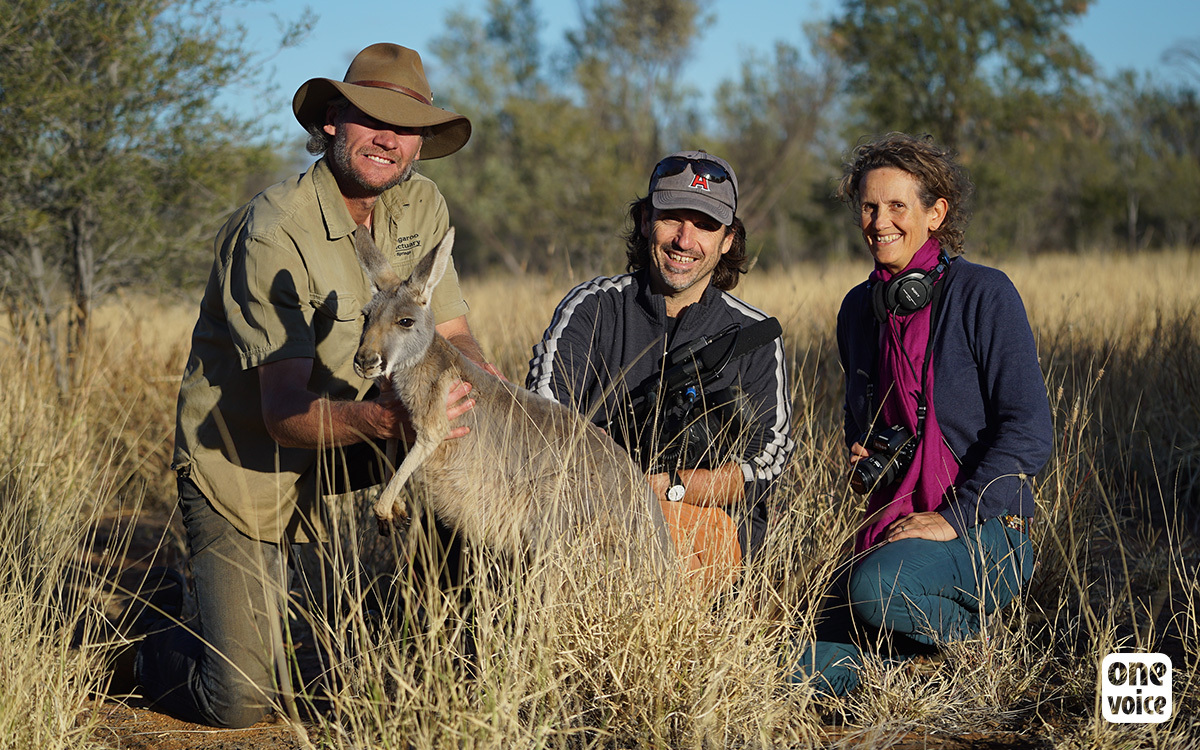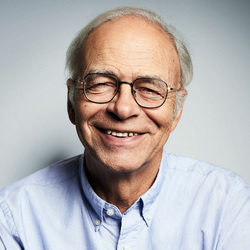

KANGAROO, the interview
We are organizing the first two venues of the documentary “Kangaroo, a love-hate story” in France. This is the exclusive interview of its directors, Mick McIntyre and Kate McIntyre Clere and Pr. Peter Singer who shed light on this issue.
How was this project born? What was the trigger?
Kangaroos are one of the most recognizable symbols in the world and have always held a fascination for us. No film had explored this icon before. We set out to make a story that celebrated this magnificent animal but soon discovered that the kangaroo was at the heart of a bitter, complex and divided situation in Australia. We were shocked to learn that millions of kangaroos are shot each year as so-called pests and sold for profit. To find out where it started and why it still happens today, we needed to investigate the origins of an industry and government partnership, which has become the largest wildlife slaughter in the world. Where had the ideology come from that a native animal that has lived in Australia for millions of years could be a national problem? How and when did Australians start believing kangaroos were a pest and therefore must be eliminated?
 «One of the worst elements is the treatment of the joeys — when the mother is shot, they often die slowly. Sometimes they are not in the pouch at the time, and hop away into the dark (kangaroo shooting usually takes place at night) and then they often die of thirst or starvation. »Pr Peter Singer
«One of the worst elements is the treatment of the joeys — when the mother is shot, they often die slowly. Sometimes they are not in the pouch at the time, and hop away into the dark (kangaroo shooting usually takes place at night) and then they often die of thirst or starvation. »Pr Peter Singer
How many kangaroos die every year? You say the number of kangaroos isn’t growing, in opposition with your government’s assessment, why?
One of the biggest issues we faced in making this film was examining the population figures that the Australian government published every year about how many kangaroos there are. So we had to unpack the survey methodology that the government uses to get those numbers. No surprise we discovered how flawed the methodology is and so we got expert testimony in how inflated the govt estimates are.We learnt that the govt has been using these inflated figures as a way of abdicating responsibility for the conservation of the kangaroo. On the subject of how many are killed we discovered that with the growth of the commercial kangaroo industry, so-called pest mitigation, recreational and illegal shooting, as well as road-kill and other accidental / collateral death, there is still very little data collected of the number of kangaroo deaths that occur daily. Some scientists and conservationists are reporting both local and regional extinctions. They don’t know how many are being killed.
What reasons do the Australian government give to consider kangaroos as pests?
When Australia was colonized by white settlers 230 years ago, the kangaroos were killed as meat for eating, but as sheep and cattle herds grew over the next 100 years, many people stopped eating them, though they were still frequently killed for sport. It didn’t take long before the white settlers began to see kangaroos as competing with their stock for feed, and damaging their crops. Later, when ecosystems collapsed from overstocking of introduced livestock, the farmers blamed the kangaroos for the damage, and decided they needed to be removed from the landscape; the Australian government facilitated this, labelling them as noxious species, and paying out millions in bounties. The idea that kangaroos are seen as a pest has continued through to the present day.
 «Animals may cause some loss to humans, of course, when they eat the crops we plant, or in the case of kangaroos, when they reduce the amount of grass available for cattle or sheep. But they are never simply a pest. They are also sentient beings with lives of their own to lead, and we should find better means of limiting their numbers and living alongside them.
«Animals may cause some loss to humans, of course, when they eat the crops we plant, or in the case of kangaroos, when they reduce the amount of grass available for cattle or sheep. But they are never simply a pest. They are also sentient beings with lives of their own to lead, and we should find better means of limiting their numbers and living alongside them.
The Australian government isn’t doing enough to protect its wildlife at all. They are too influenced by the graziers. »Pr Peter Singer
Why most of the killing is taking place at night in secret?
In filming KANGAROO we found that over time that the killing of kangaroos as so called pests had been replaced by killing millions of kangaroos for profit. The killing is government sanctioned and the shooting is done in the dead of night often miles from anywhere. There is no onsite monitoring of the killing. As kangaroos are nocturnal marsupials they are active at night and therefore shooting them in vast numbers is easiest at this time; they are also very vulnerable to the spotlight hunting method, often turning to face the light. Permits are sought to remove kangaroos from the landscape for many reasons from agricultural, land clearing for development and other human events. Although codes of practice have been developed for farmers and shooters to reduce cruelty, in many cases this is impossible to police, and research has found that non-compliance is widespread. We had whistleblowers come forward and give us first hand eyewitness accounts of the brutal treatment of kangaroos and their young joeys.
Which country or continent imports the most kangaroo products? What are they?
The largest importers of kangaroo parts are in Europe. They import kangaroo meat for pet food, meat for human consumption and skins for fashion and sports goods. The key importers for meat products are Belgium, Germany, Netherlands and France.
Are there farms that raise kangaroos for this?
No kangaroos are a wild animal that cannot be farmed. This is a wildlife slaughter.
In which conditions did you film? Was it dangerous?
For so many reasons this was an uncomfortable movie to make. Probably because its an uncomfortable issue. Most pople are shocked when they find out what is going on with the kangaroo – every night ! To find out the mass scale on which kangaroos are hunted was definitely alarming and to witness these mass shootings was traumatic. Witnessing first hand the treatment of joeys and the wounded animals dying slow deaths was disturbing. There was definitely some situations where it was more of a men’s business situation, shooting kangaroos at night, out in the wilderness. It was essential to have some strong guys on our team.
How did you choose the locations to film? How long did you film and where?
To produce “Kangaroo,” we had to travel thousands of kilometers across the magnificent red dusty Australian outback. As kangaroos are spread across the country we filmed in many national parks and farms (some as big as 300,000 acres) capturing images of the landscape and ecosystem of the kangaroo. The kangaroo themselves are shy herbivores so filming them is challenging so it took many trips to get enough filming done. We were told by famers that we could film the ‘plagues’ of kangaroos that are so often propagated in the Australian media but after 4 years filming we never came across this.In fact we were shocked by how few kangaroos we found. We also filmed in the countries who are involved in the import of kangaroo parts, like the UK and The Netherlands, we also filmed in countries that have banned the import of kangaroo parts like Russia who have banned importing kangaroo meat due to meat hygiene and California where they have a blanket ban of importing any kangaroo parts. We wanted to give the audience a comprehensive picture of what is happening to the kangaroo globally.
Who did you interview for the movie and why? What is their input?
We knew we would have to immerse ourselves in all aspects of the story and we worked to get interviews from the many differing stakeholders. We interviewed indigenous Australians, scientists, commercial shooters, farmers, politicians, artists, wildlife carers, chefs and activists
Key to the telling this story was investigating the details behind the largest wildlife slaughter in the world, to find out where it all started and why it still happens today.. We uncovered many people who have a strong emotional connection to kangaroos juxtaposing many different opinions on their status as wildlife and their “management” as pests.
 «As an Australian, I have been involved with animal issues in Australia for more than 40 years, so i am familiar with the enormous scale of the kangaroo slaughter in this country, and also with the fact that many kangaroos do not die instantly. I want to see this brought to an end, so I welcome a film that exposes how kangaroos are treated in Australia. »Pr Peter Singer
«As an Australian, I have been involved with animal issues in Australia for more than 40 years, so i am familiar with the enormous scale of the kangaroo slaughter in this country, and also with the fact that many kangaroos do not die instantly. I want to see this brought to an end, so I welcome a film that exposes how kangaroos are treated in Australia. »Pr Peter Singer
What will the audience take away?
With breathtaking footage of kangaroos in the wild, we hope this film will give the audience an up-close experience of this unique species and bring to the table a conversation that Australians seem reluctant to have. It’s time that people in Australia and across the world know what is going on with this internationally celebrated icon and ask the question: Why is no one responding to this barbaric treatment and wholesale slaughter? «We need to foster attitudes of respect for all animals, and give more consideration to their interests.
«We need to foster attitudes of respect for all animals, and give more consideration to their interests.
Please ask your government not to permit the import of products made from kangaroos: meat, fur, or leather. And of course never buy these products yourself. »Pr Peter Singer
Tickets for the venues of Paris (5th June 2018) and of Strasbourg (6th June 2018) can be purchased in advance.
Picture Credits: Cover: Hoping Pictures (Kangaroo Dundee, Mick McIntyre & Kate McIntyre Clere / Peter Singer by Aletta Vaandering